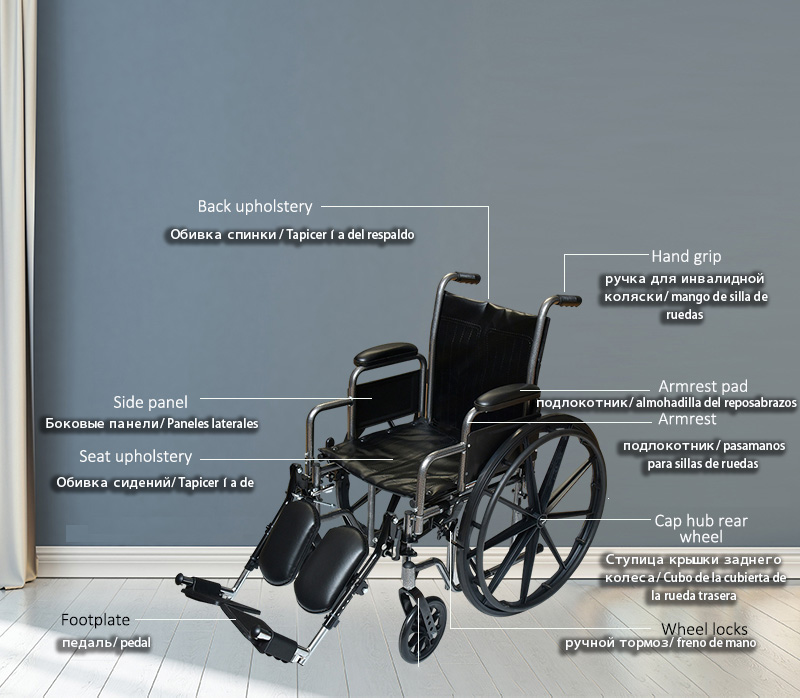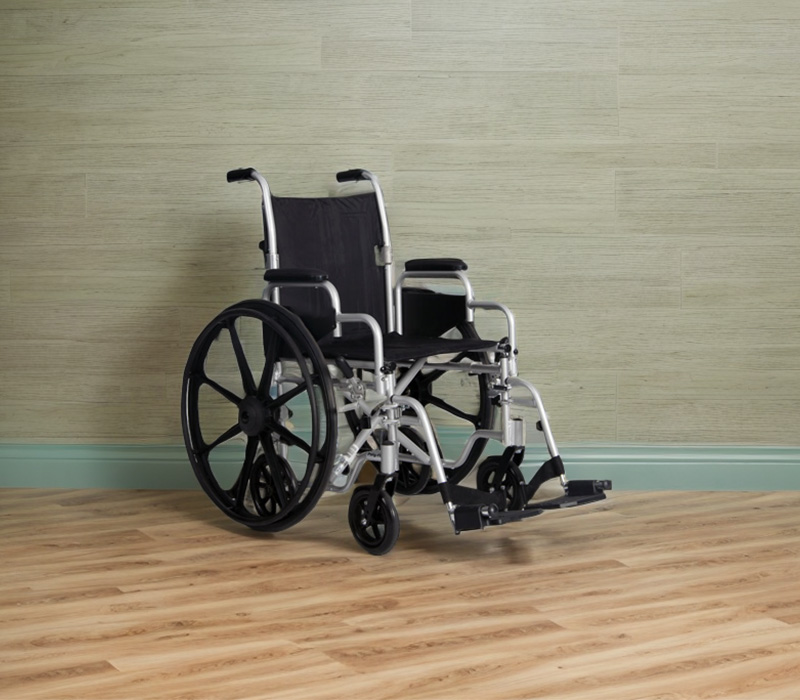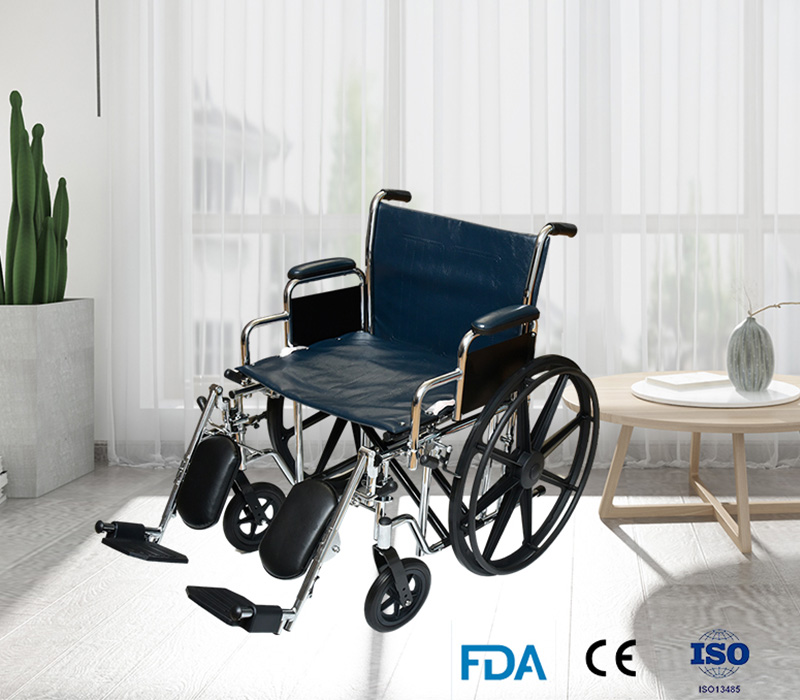Assistive devices, as an indispensable part of the daily life of disabled friends, bring a lot of convenience and help to life.
Wheelchair basics
Wheelchair concept
A wheelchair is a chair with wheels that can assist and replace walking. It is an important means of transportation for the wounded, sick, and disabled to recover at home, be transported around, see a doctor, and go out for activities.
The role of wheelchair
Wheelchairs not only meet the transportation needs of the phyically disabled and those with limited mobility, but more importantly, they make it easier for family members to move and care for the patients, allowing the patients to exercise and participate in social activities with the help of wheelchairs.
Wheelchair size
A wheelchair is made up of large wheels, small wheels, hand wheels, tires, brakes, seats and other large and small parts. Because wheelchair users require different functions, the sizes of wheelchairs are also different. According to the different body shapes of adults and children, they are also divided into children’s wheelchairs and adult wheelchairs. But basically, the total width of a conventional wheelchair is 65cm, the total length is 104cm, and the seat height is 51cm.
Choosing a wheelchair is also a very troublesome thing, but for the convenience and safety of use, it is necessary to choose a suitable wheelchair. When buying a wheelchair, pay attention to the measurement of the seat width. The best width is the distance between the two buttocks or thighs when the user sits down plus 5cm, that is, there is a gap of 2.5cm on each side after sitting down.
Structure of wheelchair
An ordinary wheelchair is gengerally composed of four parts: a wheelchair frame, wheels, a brake device and a seat. The functions of the main components of a wheelchair are briefly described below.
1.Rear wheels: carry most of the weight. The diameter of the wheel is 51,56,61,66cm. Except for a few use environments that require solid tires, pneumatic tires are mostly used.
2.Small wheels: The diameters are 12,15,18 and 20cm. The large diameter wheels are easy to cross small obstacles and special carpets. However, if the diameter is too large, the space occupied by the entire wheelchair will increase, making movement inconvenient. Normally, the small wheels are in front of the big wheels, but in wheelchairs used by people with lower limb paraplegia, the small wheels are often palced behind the big wheelhs. During operation, ut should be noted that the direction of the small wheel should be perpendicular to the large wheel, otherwise it is easy to tip over.
3.Hand wheel rim: unique to wheelchairs, the diameter is gengerally 5cm smaller than the large large wheel rim. When hemiplegis is driven by one hand, another with a smaller diameter is added for selection. The hand wheel ring is usually pushed directly by the patient.
4.Tires: There are three types: solid, pneumatic tube and tubeless pneumatic. The solid type travels faster on flat ground and is not prone to explosion, making it easy to push, but it vibrates greatly on uneven roads and is difficult to pull out when stuck in a groove as wide as the tire; Those with air-filled inner tubes are harder to push and easier to puncture, but the vibration is less than that solid ones; Tubeless inflatable types are comfortable to sit on because they don’t have an inner tube and won’t be punctured, and they are also inflated inside, but they are more difficult to push than solid ones.
5.Brake: Large wheels shuld have brakes on each wheel. Of course, if the rider can only use one hand, he has to use one-hand brake, but an extension rod can be installed to operate the brakes on both sides.
There are two types of brake
Notched brakes
This brake is safe and reliable, but it requires more effort. After adjustment, the vehicle can also brake on a slope. If it is adjusted to level 1 and cannot brake on flat ground, it is considered invalid.
Toggle brakes
Using the principle of lever, brakes are applied through several joints. Its mechanical advantage is that the notch type brake is strong, but it fails quickly. In order to increase the patient’s braking force, an extension rod is often added to the brake, but this rod is easily damaged and will affect safety if it is not checked regularly.
6.Seat: Its height, depth and width depend on the patient’s body shape, and its material texture also depends on the type of disease. Generally, the depth is 41,43cm, the width is 40,46cm, and the height is 45,50cm.
7.Seat cushion: To avoid pressure sores, seat cushions are an indispensable element, and great attention should be paid to the selection of cushions.
8.Foot and leg rests: The leg rest can be a cross-over type or a split type. Both types of supports are designed to swing to one side. You must pay attention to the height of the footrest. If the footrest is too high, the hip flexion angle will be too large, and more weight will be added to the ischial tuberosity, which may easily cause pressure sores in this area.
9.Backrest: Backrests can be high or low and can be tilted or non-tilted. If the patient has good balance and control of the trunk, a low-back wheelchair can be used to allow the patient to have greater mobility. Otherwise, a high-back wheelchair should be used.
10.Armrests: Generally, it is 22.5-25cm higher than the seat surface. Some armrests can be adjusted in height. You can also put food on the armrest for reading and eating.
Scope of use and characteristics of wheelchairs
There are many types of wheelchairs on the market. According to the materials, they can be divided into aluminum alloy, lightweight materials and steel. If according to the type, they can be divided into ordinary wheelchairs and special wheelchair. Special wheelchairs can be divided into: leisure sports wheelchair series, electronic wheelchair series, seat-side wheelchair system, standing assistance wheelchair series, etc.
Ordinary wheelchair: mainly composed of wheelchair frame, wheels, brakes and other devices.
Scope of application: people with lower limb disabilities, hemiplegia, paraplegia below the chest and elderly people with limited mobility.
Features: patients can operate fixed or detachable armrests, fixed or detachable footrests by themselves, and the device can be folded and stored when carried outside or not in use
According to the model and price, it can be divided into:hard seat, soft seat, pneumatic tire or solid tire.
Special wheelchair: It has relatively complete functions. It is not only a means of transportation for the disabled and people with limited mobility, but also has other functions.
Choice of wheelchair
There are many types of wheelchairs. The most common ones are general wheelchairs, special wheelchairs, electric wheelchais, special purpose(sports) wheelchairs, and mobility scooters.
General wheelchair: A general wheelchair is roughly in the shape of a chair, with four wheels. The rear wheel is large, with a hand wheel, brakes are also added to the rear wheel, and the front wheel is smaller, which is used for steering. An anti-tipper wheel is added to the back of the wheelchair.
Generally, wheelchair are lightweight and can be folded up.
It is suitable for people with general conditions or short-term mobility problems, and is not suitable for long-term sitting.
Special wheelchair: Depending on the patient’s condition, there are many differnet accessories, such as enhanced load capacity, special seat cushion or backrests, neck support systems, adjustable legs, removable dining tables, etc.
Electric wheelchair: A wheelchair with an electric motor.
Depending on the control method, some use a joystick, while others use various switches such as the head or breathing system.
For those with severe paralysis or who need to move a long distance, using an electric wheelchair is a good choice as long as their cognitive ability is good, but it requires a larger space for movement.
Special purpose(sports)wheelchair: A specially designed wheelchair used for recreational sports or competitions.
Common ones are racing or basketball, and dancing is also very commin.
Generally speaking, lightness and durability are the characteristics, and many high-tech materials are used.
Mobility vehicle: A broad category of wheelchairs, used by many elderly people. Generally divided into three-wheeled and four-wheeled vehicles, driven by electric motor, with a speed limit of 15km/h, and graded according to load capacity.
Wheelchair maintenance
- Before using the wheelchair and within one month, check whether the bolts are loose. If they are loose, tighten them in time. During normal use, an inspection shuold be carried out every three months to ensure that all parts are in good condition. Check the various solid nuts on the wheelchair(especially the fixing nuts of the rear wheel axle). If any looseness is found, adjust and tighten them in time.
- If the wheelchair is exposed to rain during use, it should be wiped dry in time. A wheelchair in normal use should also be wiped frequently with a soft dry cloth and coated with anti-rust wax to keep the wheelchair shiny and beautiful for a long time.
- Check the movement and flexibility of the rotating mechanism frequently and apply lubricant. If the axle of the 24-inch wheel need to be removed for some reason, make sure the nut is tightened and will not loosen when reinstalling it.
- The connecting bolts of the wheelchair seat frame are loose connections and must not be tightened.
Post time: May-19-2025



